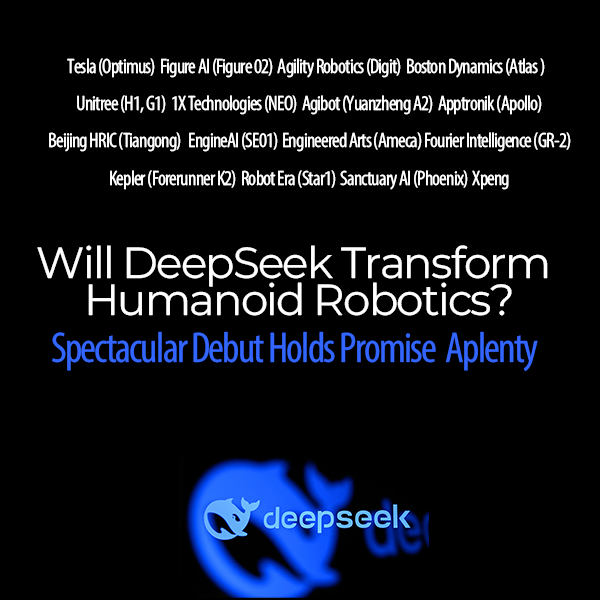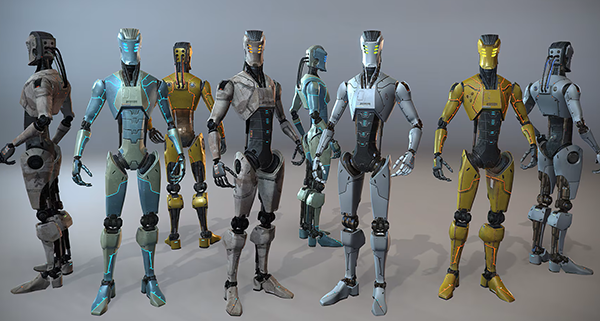
Will DeepSeek Transform Humanoid Robotics?
If DeepSeek expands into multimodal AI and optimizes for Edge AI, it could become a dominant force in humanoid robotics, challenging even the most advanced proprietary models.
What are the odds of success?
“LLM token prices have been falling rapidly, and open weights have contributed to this trend and given developers more choice. OpenAI’s o1 costs $60 per million output tokens; DeepSeek R1 costs $2.19. This nearly 30x difference brought the trend of falling prices to the attention of many people.”
—Andrew Ng
This week’s online world has been understandably filled with seemingly round-the-clock, wall-to-wall DeepSeek news. What does it all mean for robotics, specifically humanoid robots? We went looking, and here’s what we gleaned from the deluge.
We knew that the integration of artificial intelligence (AI) into humanoid robotics has long been a goal for researchers and developers, aiming to create more autonomous, intelligent, and interactive machines. What specifically has advanced that search for integration?

Humanoids (and other robots), it seems you’ve got a friend!
DeepSeek represents a significant breakthrough in this field, offering a cost-effective, high-performance AI model that enhances humanoid robot capabilities. By enabling efficient computation, natural language processing, and multimodal learning, DeepSeek has the potential to reshape how humanoid robots function in real-world applications.
The debris field from this week’s DeepSeek explosion and market takedown has exposed more than a few benefits for robotics, especially for humanoid robots. Doing more with less, ensuring that the results were all open source, and presenting real-world ways to cut costs, heralded China’s entry onto the worldwide stage of AI and LLM innovation. It’s name is DeepSeek.
It seems that DeepSeek’s capabilities, especially in large language models and AI-driven reasoning, can significantly enhance humanoid robots.
Here’s what we know. It’s quite the list:
- Cost-Effectiveness
- Optimized Learning & Adaptation: DeepSeek’s AI can help humanoid robots learn from fewer real-world interactions, reducing the need for expensive hardware testing and iterative redesigns.
- Efficient Simulation & Digital Twins: AI-driven simulations can refine robot behaviors before deployment, cutting down material costs.
- Edge AI Efficiency: With DeepSeek’s potential for optimization, it can help robots process information locally instead of relying heavily on cloud computing, reducing operational costs.
- Efficiency
- Advanced Natural Language Understanding: DeepSeek’s language models can improve robots’ ability to understand and respond naturally, making them more effective in human-robot collaboration.
- Enhanced Decision-Making: AI-driven reasoning can enable humanoid robots to make more autonomous, intelligent decisions in dynamic environments.
- Task Generalization: Robots can learn tasks more efficiently and adapt them across different environments, improving flexibility and reducing retraining costs.
- Intelligence
- Better Multimodal Understanding: If DeepSeek expands into multimodal AI (text, vision, and audio), robots can gain a richer understanding of their environment.
- Autonomous Learning & Self-Improvement: AI like DeepSeek can allow robots to self-optimize based on past interactions, making them smarter over time.
- Personalization & Context Awareness: DeepSeek could enable humanoid robots to personalize interactions with users, remembering preferences and adapting behaviors.
The Importance of Being Open-Source
- Faster Innovation: Open-source models allow the global AI and robotics community to iterate and improve upon them rapidly.
- Cost-Reduction: Companies and researchers can use and modify DeepSeek without prohibitive licensing fees, making AI-driven humanoid robots more accessible.
- Customization & Specialization: Developers can fine-tune DeepSeek for specific robotic applications, ensuring better performance in niche tasks.
- Transparency & Trust: Open-source AI fosters trust by allowing experts to audit for biases, security issues, and robustness.
DeepSeek’s open-source nature is a game-changer. It democratizes AI for humanoid robots, making them more cost-effective, adaptable, and intelligent. This could accelerate real-world applications in industries like healthcare, manufacturing, and personal assistance, making humanoid robots more practical for widespread use.
ChinaTalk: Kevin Xu and Jordan Schneider explain in detail what’s going on behind the DeepSeek R&D curtain. Fascinating look at innovating with less in order to achieve more. Importance for robotics cannot be overlooked. Well worth watching.
DeepSeek stands out in AI-driven robotics when compared to other major AI models, such as OpenAI’s GPT-4, Google DeepMind’s Gemini, and Meta’s Llama. Something like this:
- Cost & Accessibility (Open-Source vs. Proprietary)
- DeepSeek: Open-source, making it freely available for customization and integration into robotics without restrictive licensing fees. This lowers the cost barrier for startups and researchers.
- GPT-4 & Gemini: Proprietary, requiring API access or enterprise-level contracts, which increases costs and limits modification potential.
- Llama 2: Open-source but with commercial restrictions; still less permissive than DeepSeek.
- Mistral: Another strong open-source competitor but focused more on text-based applications rather than robotics.
Why It Matters: Open-source AI like DeepSeek allows robotics companies to fully integrate and customize the model for real-world humanoid applications without depending on third-party APIs.
- Adaptability for Robotics
- DeepSeek: Optimized for reasoning and potential multimodal capabilities, making it well-suited for robotics that require situational awareness.
- GPT-4 & Gemini: Strong in language processing and multimodal understanding, but less customizable due to proprietary constraints.
- Llama 2: Good for text-based interactions but lacks direct optimization for robotics.
- Mistral: Efficient for NLP tasks but has limited applications in physical robotics.
Why It Matters: Humanoid robots require real-time decision-making, not just language-based interactions. DeepSeek’s potential flexibility and reasoning capabilities make it ideal for autonomous decision-making in physical environments.
- Multimodal Capabilities (Vision, Speech, Text)
- DeepSeek: If it expands into multimodal AI (vision, speech, and text), it could rival leading AI models in understanding robotic perception.
- GPT-4 (Vision) & Gemini: Already multimodal, excelling in processing images and videos alongside text, making them highly capable for vision-based robotics.
- Llama 2 & Mistral: Primarily text-based, lacking built-in multimodal functions.
Why It Matters: For humanoid robots, combining vision, speech, and text is crucial for real-world navigation and interaction. If DeepSeek advances in multimodal AI, it could directly compete with GPT-4 Vision and Gemini.
- Edge AI & On-Device Efficiency
- DeepSeek: If optimized for edge AI, it can run on local robotic hardware without constant cloud dependence, improving efficiency.
- GPT-4 & Gemini: Cloud-based and resource-intensive, limiting real-time robotic applications in low-latency environments.
- Llama 2 & Mistral: More lightweight, but not as powerful in reasoning as DeepSeek.
Why It Matters: Running AI models directly on robotic hardware (Edge AI) is critical for real-time interactions in autonomous systems. If DeepSeek is optimized for this, it could surpass larger models that require cloud processing.
- Scalability & Customization
- DeepSeek: Fully customizable for specific robotic applications, from warehouse automation to humanoid assistants.
- GPT-4 & Gemini: Scalable but controlled by corporate entities, limiting deep customization.
- Llama 2 & Mistral: Open but not as optimized for robotics.
Why It Matters: The ability to fine-tune AI for specific robotic use cases (e.g., factory robots vs. personal assistants) makes DeepSeek a strong candidate for industrial and consumer applications.
Final Verdict
- DeepSeek vs. GPT-4/Gemini: DeepSeek offers more flexibility due to its open-source nature but needs further multimodal advancements to fully compete.
- DeepSeek vs. Llama 2/Mistral: More suited for robotics due to its reasoning and potential multimodal capabilities.
- Best Use Case for DeepSeek: Humanoid robots needing cost-effective, adaptive AI with open-source customization.
